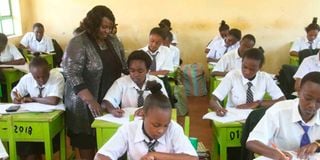Education wins big, with TSC getting Sh16bn more

The education sector is among the biggest beneficiaries in this year’s budget, according to the proposals presented in Parliament Thursday by National Treasury CS Ukur Yatani.
The education sector is among the biggest beneficiaries in this year’s budget, according to the proposals presented in Parliament Thursday by National Treasury Cabinet Secretary Ukur Yatani.
The CS proposed an allocation of Sh544.4 billion for the sector, with the Teachers Service Commission (TSC) taking the lion’s share of the funds.
Mr Yatani proposed Sh298.4 billion for TSC, a big increase from the Sh281.7 billion it received in last year’s budget.
However, primary school heads will be disappointed, as Mr Yatani gave Sh12 billion to the free primary education programme, the same amount as last year, despite complaints that schools require more money to run the institutions.
The capitation for learners in primary schools has remained the same (Sh1,420) since the programme was established in 2003, despite inflation over the years.
Free day secondary education
Secondary school principals will be happier after the CS proposed an allocation of Sh64.4 billion, up from the Sh62.2 billion the schools received last year under the free day secondary education programme. The allocation includes funds meant for learners’ insurance under the National Hospital Insurance Fund. Out of the proposed allocation to the TSC, Sh2.5 billion will go towards the recruitment of teachers and Sh1.2 billion for training of teachers on the competency-based curriculum. Sh5 billion will fund the examination fee waiver for Grade Six, Standard Eight and Form Four candidates, while Sh1.96 billion has been allocated to the school feeding programme.
Mr Yatani has allocated Sh310 million for the digital literacy programme and ICT integration in secondary schools. He said the government rolled out radical reforms in the education sector that have significantly improved the quality of education. He said the investment has seen the number of primary schools increase from 26,549 to 32,437 and secondary schools from 7,174 to 10,413 between 2012 and 2020. The number of technical and vocational education and training institutions also increased from 701 to 2,301 in the same period.
“The transition rate from primary to secondary schools moved from 64.5 percent in 2012 to the current 100 percent,” he said.






